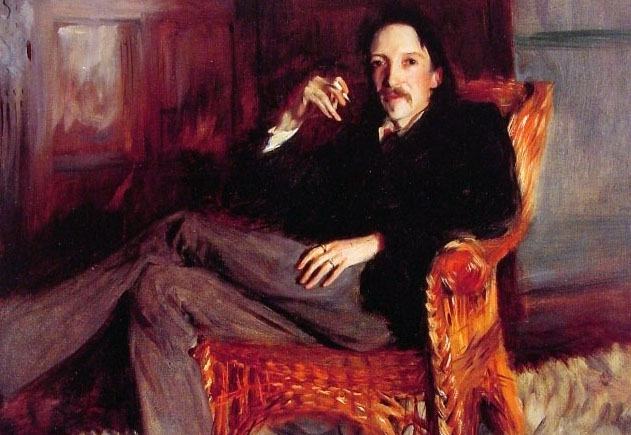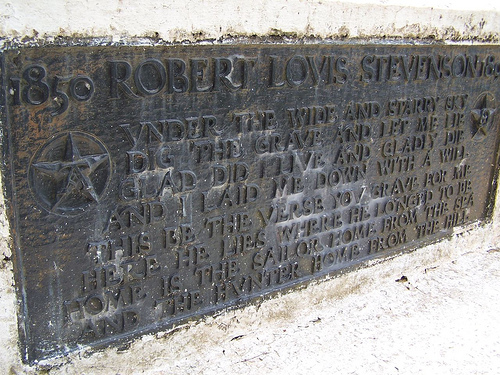【Schoolmistress 2】
On Epitaphic Fictions: Robert Louis Stevenson,Schoolmistress 2 Philip Larkin
Arts & Culture
The second in a three-part series on writers’ epitaphs. Read yesterday’s installment here.

John Singer Sargent, Portrait of Robert Louis Stevenson, 1887
There is very little that’s puzzling about Philip Larkin’s two-penny upright “This Be the Verse” (1971):
They fuck you up, your mum and dad.
They may not mean to, but they do.
They fill you with the faults they had
And add some extra, just for you.But they were fucked up in their turn
By fools in old-style hats and coats,
Who half the time were soppy-stern
And half at one another’s throats.Man hands on misery to man.
It deepens like a coastal shelf.
Get out as early as you can.
And don’t have any kids yourself.
“This Be the Verse” is arguably the best-loved English poem of the last half of the twentieth century. Funny, frank, transgressive—human—the poem has stood up admirably in pub, alley, and classroom. (Of how many humanswith fancy titles can this be said?) But what about that awkward title? How did a writer as good as Larkin fuck up his forms of to be?
The title’s oddness is no empty gesture. The words “This Be the Verse” point us toward one of the sweetest, un-Larkin-esque poems in the language, Robert Louis Stevenson’s self-composed epitaph. When it’s published in an anthology, it usually appears as two stanzas called “Requiem,” but on Stevenson’s tomb, the epitaph is presented as a single block under his name and dates, without punctuation or title: 
Under the wide and starry sky,
Dig the grave and let me lie,
Glad did I live and gladly die,
And I laid me down with a will.This be the verse you grave for me:
Here he lies where he longed to be,
Home is the sailor, home from sea,
And the hunter home from the hill.
“Requiem” offers us several moving fictions. The principal inducer of make-believe here is the utter smoothness and rhythmic consistency of the poem. (That second “the” on line seven is a plaque-maker’s error.) The sounds this text makes—one almost bursts into song reciting it—correspond to conventional notions of what it meant to write beautiful English verse in the late-nineteenth century.
But Stevenson suffered from tuberculosis, and the beauty here evinces a tubercular’s desire for a calm and musical passing, his wish to skip the bits of lung hacked up in the back of the throat, the blood-spattered kerchiefs and pillowcases. The most striking fiction in the first stanza, perhaps, is the fiction that one is as glad to die as one has been to live. Line three—with its mellifluous repetition of all the sounds that occur in “glad did I live” in the phrase “gladly die”—doubles down on this fiction, which is backed up by the punning end of line four, where “will” sounds out Stevenson’s sense that these lines are his final testament, a strong-willed, perhaps even willful, presentation of his legacy. See how the word “grave,” which arrives in line two as a noun, reappears, in line five, as a verb? Stevenson’s epitaph transforms a hole in the ground into an active making.
Stevenson’s fight with tuberculosis was more retreat than attack. A Scot, born in Edinburgh, he wrote beautifully from many places in whose climates he sought relief from the symptoms of his disease: Dorset, Davos, coastal California, Hyères, the Adirondacks, Hawaii, New Zealand. He died and was buried in Samoa, about 9460 miles from his birthplace, so Google tells me. In light of that fact, few lines pluck at one’s heartstrings so strongly as the sentimental fiction, “Home is the sailor, home from sea / And the hunter home from the hill.” Even on his own tomb, Stevenson tells us the story we want to hear regarding our own eventual resting places, though he must lie so far from home.
Larkin’s use of Stevenson’s words hides the epitaphic frame of “This Be the Verse” in plain sight. (I have found, on a long-disused thread, a famous poet’s admission of how even she, in the days before the Internet, had for nearly a decade never bothered to look up the reference.) His use of the phrase indicates that Larkin’s speaker, too, is concerned about what somebody will “grave” on his headstone, which, like Ben Franklin’s headstone, is only a notion—it doesn’t yet exist, and won’t for some time. (Larkin’s actual headstone would end up bearing no epitaph.)

Photo: Keith D, via Wikimedia Commons
The fictions in Stevenson’s “Requiem” are generous, if sentimental. Are the fictions of “This Be the Verse” as generous? I think so. Their generosity derives in part from Larkin’s inversion of Stevenson’s sentimentality, and in part from his dipping the speaker’s instructions in irony. Larkin tacitly invites us to imagine coming upon “They fuck you up, your mum and dad” on a headstone, under anybody’s name, two dates, and a hyphen. (The hyphen is itself a moving figure, so compact is the rectangular mark that stands for a life.) Our laughter at “This Be the Verse” expresses our surprise at finding such inappropriate diction carved in a so upright a font, and taking so stern a posture.Larkin’s poem places his speaker in a continuous series of generations, each human member of which may live for only a hyphen’s length—but that’s long enough to realize that human misery is general, that our discrete pain and suffering is part of something greater. The command that follows the only vivid image in the poem—misery deepening “like a coastal shelf”—is a non sequitur. “Get out as early as you can.” We can hardly follow it any more than we could follow Yeats’s imperative, “Horseman, pass by.” Misery loves company, but in our experience of “This Be the Verse,” the misery is only fiction. The laughter we share when we read Larkin’s imagined epitaph is real.
Daniel Bosch is Senior Editor at Berfrois. His sonnet sequence “To a Barista” is at The Common; his meditation on race and invocation will appear later this week at The Morning News.
Search
Categories
Latest Posts
Samsung Unpacked stream is set for May 12, 2025
2025-06-26 06:01'The Predator' gets even bigger and meaner
2025-06-26 05:29Watch the powerful ESPY Awards speech by Larry Nassar survivors
2025-06-26 04:384 things you can do to help keep Nelson Mandela's legacy alive
2025-06-26 04:33Watch how an old Venus spacecraft tumbled before crashing to Earth
2025-06-26 04:26Popular Posts
Pavlov the Corgi graduates from UCLA
2025-06-26 05:47Justin Bieber impersonates Miley Cyrus in a brain
2025-06-26 04:51Bitcoin passes $7 thousand and *people are excited
2025-06-26 04:38Put Me In, Coach!
2025-06-26 03:59Featured Posts
Best Garmin deal: Save over $100 on Garmin Forerunner 955
2025-06-26 06:00Your guide to navigating the anti
2025-06-26 05:3414 reasons why Hillary Clinton is a big f*cking deal today
2025-06-26 05:332018 is only halfway over, but a troubling warming trend is apparent
2025-06-26 05:24The Mismeasure of Media
2025-06-26 05:11Popular Articles
Philips now allows customers to 3D print replacement parts
2025-06-26 05:45US voters' data left exposed online
2025-06-26 05:33Volkswagen will build two all
2025-06-26 05:25SpaceX's Starlink satellite launch in pictures
2025-06-26 04:53Newsletter
Subscribe to our newsletter for the latest updates.
Comments (569)
Miracle Information Network
AMD Radeon RX 550 + Intel Pentium G4560
2025-06-26 06:04Steady Information Network
'Silicon Valley' star accuses T.J. Miller of being 'a bully' on set
2025-06-26 05:05Wave Information Network
People are furious that straight white guys aren't allowed to attend an equality conference
2025-06-26 04:56Reality Information Network
Instagram now lets you see when your friends are online
2025-06-26 04:26Transmission Information Network
Mary Shows Up
2025-06-26 04:25